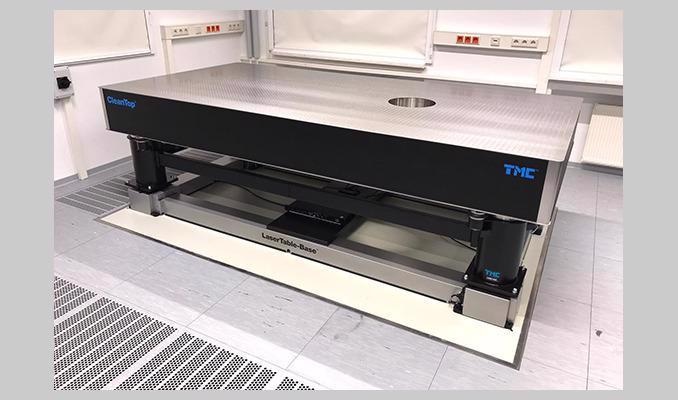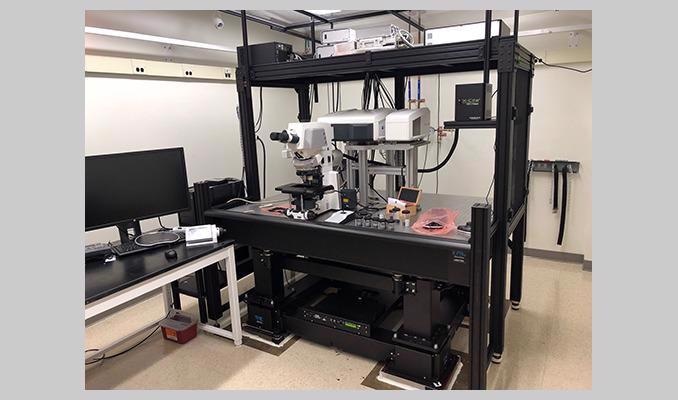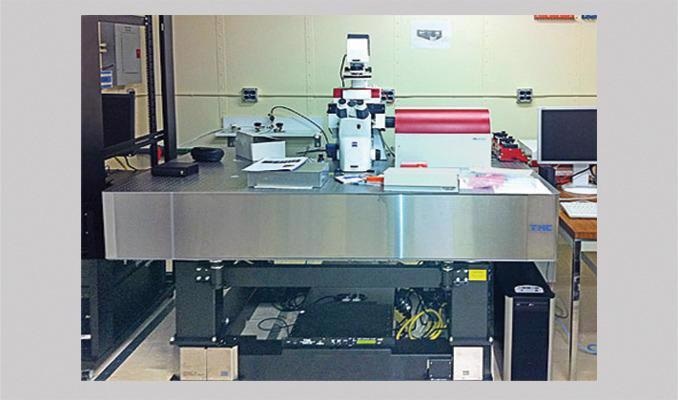 Interview conducted by Olivia FrostFeb 24 2022
Interview conducted by Olivia FrostFeb 24 2022In this interview, Wes Wigglesworth, the Product Manager at TMC, talks to AZoM about their advanced hybrid vibration isolation system for optical tables.
To begin, can you give us an introduction to Laser Tables and how they are typically supported?
Laser Tables, also known as Optical Tables, are the backbone of many physics, chemistry, laser, and photonics (to name a few) research labs. These are large tables constructed of a stiff honeycomb core and outer steel plates, or “skins”.

The top skin is typically drilled and tapped with a grid of holes for mounting components and instruments. The table itself provides no mitigation from floor vibration, as this is something dependent on the structure supporting the table.
What is a LaserTable-BaseTM, and how is it unique in the industry?
LaserTable-Base is an advanced hybrid vibration isolation system for Optical Tables or any device or instrument sensitive to the floor and building vibration.
LaserTable-Base offers an extraordinary level of improvement over traditional pneumatic isolation in terms of overall vibration isolation from sub-Hz to very high-frequency floor vibration. Though very effective at isolating higher frequencies, pneumatic passive systems actually amplify vibration in the critical 1 to 3 Hz range due to their own natural resonance.

Along with highly effective pneumatic isolation, LaserTable-Base incorporates TMC STACIS® technology which overcomes these limitations through proprietary technology incorporating piezoelectric actuators and inertial vibration sensors to cancel, not amplify, very-low-frequency vibration. LaserTable-Base combines these two technologies, air, and STACIS, into one integrated cancellation system. The result is vibration cancellation at very low frequencies and unprecedented levels of high-frequency isolation due to the combined effect of two isolation systems in series.
There really is nothing else like it commercially available.
What are the advantages of having two different types of isolation systems?
When combining both TMC’s Micro-g® pneumatic and STACIS into one integrated cancellation system, the result is vibration cancellation at very low frequencies and unprecedented levels of high-frequency isolation due to the combined effect of two isolation systems in series. It is a classic example of “best of both worlds.”
Does it matter which one goes on top, and why is this?
Yes, this is critically important. The first level of isolation must be very stiff to support the second level. This impedance mismatch, or two springs with significantly different natural frequencies, significantly reduces or eliminates isolation degradation when isolators of similar resonance are “stacked.” The first tier of LaserTable-Base incorporates the STACIS technology and is inherently very stiff compared to the 2nd tier passive pneumatic isolator.
Can this system be easily configured for a custom application?
In fact, TMC is well known for working closely with engineers and researchers to customize a solution to meet their specific needs. LaserTable-Base is no exception. We can customize the height, load capacity, length, and width. We have even designed a system to support an “L” shaped table.
What was the main inspiration behind the development of the LaserTable-Base and its related technologies?
As scientists and researchers continue to push the envelope in terms of resolution and finer geometries, they often experiment with stacking different types of vibration isolation systems. Years ago, we worked with a lab to provide a separate STACIS floor platform to support an optical table with traditional pneumatic isolation.

STACIS was the original hard-mount piezoelectric active cancellation technology developed in the 1990s. This was really an “ah-ha” moment for us, which soon led to our commercialization of a cost-effective solution integrating the two technologies in one complete support frame.
During the systems development, what were some of the main challenges you came up against when combining two isolation systems, and how were these overcome?
With any true active vibration cancellation control system, dynamic range and floor noise always pose a challenge. It is important to develop a system with components such as inertial sensors, amplifiers, and actuators that enable a high dynamic range with a very low noise floor.
The next issue unique to stacking such systems is that if done incorrectly, the 2nd tier pneumatic isolator could effectively “give back” the vibration in the 1-3Hz range that the first tier eliminates. TMC has worked many years developing highly damped pneumatic systems, specifically MaxDamp® and UltraDampTM, so we already had the ideal solution.
How does someone know when they need to use LaserTable-Base vs. a single-stage isolation system for their application?
Some commercial instruments publish a vibration specification, in which case it’s easy – measure your floor vibration and compare it to that spec and determine the appropriate solution. TMC’s sales and application team can help with that.
On the other hand, many applications in single-molecule biophysics, laser interferometry, and quantum physics, for example, require vibration levels lower than the most advanced and most sensitive electron microscopes. In such demanding applications, or often in upper floors with less demanding applications, aggressive attenuation of both very low frequency (2Hz and below) and high frequency is needed and often only provided by a solution such as the LaserTable-Base.
Can you give an example of when the LaserTable-Base has been used to meet strict floor vibration criteria requirements in a very noisy environment?
In this application note, Dr. Aliaksei Charnukha required a table with vibration levels in the VC-E to VC-F range. Locating the cryogenic nano-optical instrumentation near road traffic was less than ideal, but this was the only space available. LaserTable-Base was installed and reduced the floor from above VC-E to below VC-G.
Where can readers find more information?
https://www.techmfg.com/learning/whitepapers/optical-table-advances
https://www.techmfg.com/learning/whitepapers/piezo-driven-active-vibration-control-pushes-limits
https://www.techmfg.com/learning/whitepapers/performance-loss-in-stacked-vibration-isolation-systems
About Wes Wigglesworth
Wes Wigglesworth has been with TMC since 1997 and is currently the Product Manager for TMC’s flagship line of Active Vibration and Noise cancellation systems, including STACIS, STACIS iX, Mag-NetX, and the new Everstill.
Wes has previously held positions in Application Engineering, Sales Engineering, and OEM Account Management in the scientific and technology industry over a period of over 24 years.
He holds a bachelor's degree in Electrical Engineering from Tufts University in Medford, MA.
Disclaimer: The views expressed here are those of the interviewee and do not necessarily represent the views of AZoM.com Limited (T/A) AZoNetwork, the owner and operator of this website. This disclaimer forms part of the Terms and Conditions of use of this website.